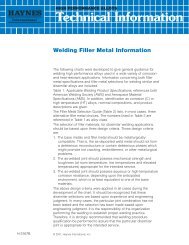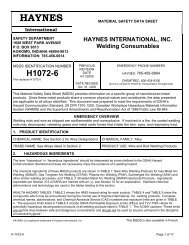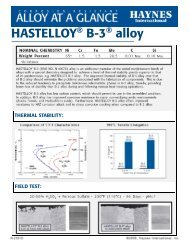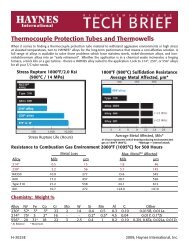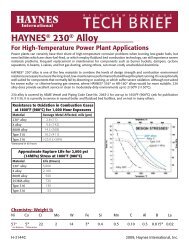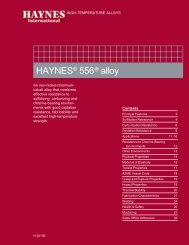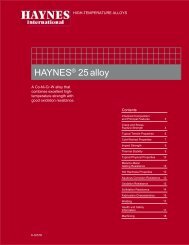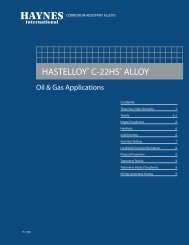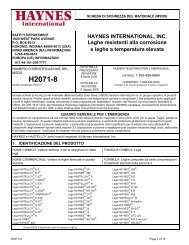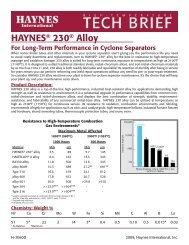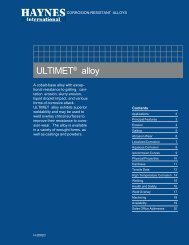Haynes International, Inc.
Haynes International, Inc.
Haynes International, Inc.
- No tags were found...
Create successful ePaper yourself
Turn your PDF publications into a flip-book with our unique Google optimized e-Paper software.
PRINCIPAL FEATURESOutstanding Corrosion Resistance, High StrengthHASTELLOY ® C-22HS TM alloy** is corrosion-resistant, nickel-chromium-molybdenum alloywhich can be heat treated to obtain a strength approximately double that of other C-typealloys. Importantly, the corrosion resistance and ductility of the alloy remain excellent when inthe high strength condition. In addition to its high uniform corrosion resistance in oxidizing aswell as reducing environments, the as-heat treated C-22HS alloy possesses high resistance tochloride-induced pitting and crevice corrosion attack.Product FormsC-22HS alloy is available in the form of plate, sheet, strip, billet, bar, wire, pipe, and tube.Heat TreatmentThe high strength of C-22HS alloy is derived from the formation of strengthening particles ofNi 2 (Mo,Cr) which form during the patented*** two-step age-hardening heat treatment. Theapproximately 48 hour heat treatment, 1300°F (705°C) FC to 1125°F (605°C)/32 hours/AC, isdescribed in more detail on page 14.Solution Annealed and Filler Wire ApplicationsC-22HS alloy may also be considered for applications which do not require the high strengthimparted by the heat treatment. In the annealed condition, C-22HS alloy has even highercorrosion-resistance, particularly with regard to localized corrosive attack. This localizedattack resistance also makes the alloy an attractive candidate as a general-purpose filler metal orweld overlay.Applications• Agitators and blenders• Shafting• Fan blades and hubs• Fasteners• Springs• Valves• Dies• Screws• Wellhead parts• Rings and gasketsField Test ProgramSamples of C-22HS alloy in the age-hardened condition are available for field trials.Furthermore, samples can be weighed prior to delivery, and then reweighed after test by thecustomer, and reports provided on corrosion rates and other observations. For samples,please contact one of the <strong>Haynes</strong> <strong>International</strong> Service Centers listed on the back cover of thisbrochure.** Covered by U.S. Patent 6,860,948*** Covered by U.S. Patents 6,544,362 and 6,638,373COMPOSITIONNi Cr Mo Fe Co W Mn Al Si C BBAL 21 17 2* 1* 1* 0.8* 0.5* 0.08* 0.01* 0.006**Maximum3HASTELLOY ® C-22HS® alloy
PHYSICAL PROPERTIES*Physical Property Metric Units British UnitsDensity (annealed) RT 8.60 g/cm.³ RT 0.311 lb/in.³Density (age-hardened) RT 8.64 g/cm.³ RT 0.312 lb/in.³Electrical Resistivity RT 0.98 μohm.m RT 38.4 μohm.in100°C 1.00 μohm.m 200°F 39.3 μohm.in200°C 1.04 μohm.m 400°F 41.1 μohm.in300°C 1.08 μohm.m 600°F 42.8 μohm.in400°C 1.12 μohm.m 800°F 44.3 μohm.in500°C 1.15 μohm.m 1000°F 45.5 μohm.in600°C 1.17 μohm.m 1100°F 46.0 μohm.inThermal Conductivity RT 11.8 W/m.°C RT 82 btu.in/h.ft².°F100°C 13.5 W/m.°C 200°F 93 btu.in/h.ft².°F200°C 15.4 W/m.°C 400°F 107 btu.in/h.ft².°F300°C 17.1 W/m.°C 600°F 120 btu.in/h.ft².°F400°C 18.6 W/m.°C 800°F 132 btu.in/h.ft².°F500°C 20.5 W/m.°C 1000°F 147 btu.in/h.ft².°F600°C 22.4 W/m.°C 1100°F 154 btu.in/h.ft².°FMean Coefficient of 25-100°C 11.6 μm/m.°C 70-200°F 6.4 μin/in.°FThermal Expansion 25-200°C 12.0 μm/m.°C 70-400°F 6.7 μin/in.°F25-300°C 12.4 μm/m.°C 70-600°F 6.9 μin/in.°F25-400°C 12.7 μm/m.°C 70-800°F 7.1 μin/in.°F25-500°C 13.1 μm/m.°C 70-1000°F 7.3 μin/in.°F25-600°C 13.3 μm/m.°C 77-1100°F 7.4 μin/in.°FThermal Diffusivity RT 0.0334 cm²/s RT 0.129 ft²/h100°C 0.0362 cm²/s 200°F 0.139 ft²/h200°C 0.0398 cm²/s 400°F 0.155 ft²/h300°C 0.0427 cm²/s 600°F 0.167 ft²/h400°C 0.0454 cm²/s 800°F 0.180 ft²/h500°C 0.0489 cm²/s 1000°F 0.194 ft²/h600°C 0.0517 cm²/s 1100°F 0.200 ft²/hSpecific Heat RT 412 J/kg.°C RT 0.098 btu/lb.°F100°C 434 J/kg.°C 200°F 0.103 btu/lb.°F200°C 451 J/kg.°C 400°F 0.108 btu/lb.°F300°C 465 J/kg.°C 600°F 0.112 btu/lb.°F400°C 477 J/kg.°C 800°F 0.115 btu/lb.°F500°C 488 J/kg.°C 1000°F 0.118 btu/lb.°F600°C 504 J/kg.°C 1100°F 0.120 btu/lb.°FDynamic Modulus of RT 223 GPa RT 32.3 x 10 6 psiElasticity 100°C 218 GPa 200°F 31.6 x 10 6 psi(Young's Modulus) 200°C 211 GPa 400°F 30.5 x 10 6 psi300°C 209 GPa 600°F 30.2 x 10 6 psi400°C 205 GPa 800°F 29.5 x 10 6 psi500°C 195 GPa 1000°F 27.6 x 10 6 psi600°C 181 GPa 1100°F 26.4 x 10 6 psiMelting Range 1304 - 1368°C 2380 - 2495°F* Properties are for material in the age-hardened condition unless otherwise noted.HAYNES ® C-22HS® alloy 4
UNIFORM CORROSION DATA (C-22HS, C-22)Chemical Conc. TemperatureCorrosion Ratewt.% °C °F C-22HS Annealed C-22HS Age-Hardened C-22mm/y mpy mm/y mpy mm/y mpyHydrochloric 1 Boiling 0.09 3.6
UNIFORM CORROSION DATA (C-276, 625)Chemical Conc. TemperatureCorrosion Ratewt.% °C °FC-276625mm/y mpy mm/y mpyHydrochloric 1 Boiling 0.33 13.0 0.23 8.9Acid 5 79 175 0.75 29.4 4.65 183.010 38 100 0.17 6.8 0.30 11.920 38 100 0.14 5.4 0.36 14.1Hydrobromic 2.5 Boiling 0.13 5.0
ISO-CORROSION DIAGRAMSEach of these iso-corrosion diagrams was constructed using numerous corrosion rate values,generated at different acid concentrations and temperatures. The blue line represents thosecombinations of hydrochloric acid concentration and temperature at which a corrosion rate of 0.1mm/y (4 mils per year) is expected, based on laboratory tests. Below the line, rates under 0.1 mm/yare expected. Similarly, the red line indicates the combinations of acid concentration andtemperature at which a corrosion rate of 0.5 mm/y (20 mils per year) is expected. Above the redline, rates of over 0.5 mm/y are expected. Between the blue and red lines, corrosion rates areexpected to fall between 0.1 and 0.5 mm/y.AnnealedHAYNES ® C-22HS® alloy 8
ISOCORROSION DIAGRAMSAge-Hardened9HASTELLOY ® C-22HS® alloy
MECHANICAL PROPERTIESTypical Tensile Data for Cold-Rolled and Solution Annealed SheetMetric Units0.2% Offset UltimateTemperature Yield Tensile Elongation TemperatureStrength StrengthBritish Units0.2% OffsetYieldStrengthUltimateTensileStrengthElongation°C MPa MPa % °F ksi ksi %RT 439 837 57.3 RT 63.6 121.4 57.3100 394 807 59.9 200 57.6 117.4 60.0200 343 754 58.6 400 49.4 108.9 58.5300 316 734 66.8 600 45.3 106.0 68.2400 308 718 69.6 800 44.4 103.6 70.1500 296 691 67.8 1000 42.2 98.3 66.5600 288 665 69.9 1200 40.1 94.8 68.5Typical Tensile Data for Hot-Rolled and Solution Annealed Plate and BarTemperature0.2%OffsetYieldMetric UnitsUltimateTensileStrengthElongationReductionin AreaTemperature0.2%OffsetYieldBritish UnitsUltimateTensileStrengthElongationReductionin AreaStrengthStrength°C MPa MPa % % °F ksi ksi % %RT 376 806 62.3 77.5 RT 54.4 117.0 62.3 77.5100 329 767 66.7 78.0 200 48.0 111.7 66.8 78.6200 288 721 65.9 77.3 400 41.4 104.2 65.8 77.1300 263 695 68.8 75.2 600 37.5 100.2 69.2 74.9400 255 677 69.5 73.0 800 36.7 97.5 69.6 72.3500 241 652 69.3 70.9 1000 34.1 93.0 69.1 70.2600 223 628 70.6 69.1 1200 31.3 90.1 71.4 67.7Typical Room Temperature HardnessesFormHardnessMill AnnealedAge-HardenedPlate 92 Rb 30 RcSheet 90 Rb 30 RcBar 88 Rb 30 RcHAYNES ® C-22HS® alloy 10
MECHANICAL PROPERTIESTypical Tensile Data for Cold-Rolled, Solution Annealed, and Age-Hardened SheetMetric UnitsBritish UnitsTemperature0.2% OffsetYieldStrengthUltimateTensileStrengthElongationTemperature0.2% OffsetYieldStrengthUltimateTensileStrengthElongation°C MPa MPa % °F ksi ksi %RT 759 1230 40.9 RT 110.0 178.4 40.9100 710 1190 43.6 200 103.5 173.1 43.7200 658 1131 43.4 400 95.0 163.6 43.3300 630 1103 47.8 600 90.7 159.5 48.5400 590 1049 48.2 800 84.1 149.8 48.1500 572 1003 47.1 1000 82.3 143.3 46.6600 547 928 46.3 1100 79.8 135.2 46.4Typical Tensile Data for Hot-Rolled, Solution Annealed, and Age-Hardened Plate and BarTemperature0.2%OffsetYieldMetric UnitsUltimateTensileStrengthElongation Reductionin AreaTemperature0.2%OffsetYieldBritish UnitsUltimateTensileStrengthElongation Reductionin AreaStrengthStrength°C MPa MPa % % °F ksi ksi % %RT 690 1202 44.2 57.7 RT 100.1 174.2 44.2 57.7100 627 1153 47.7 55.7 200 91.3 167.9 47.7 55.5200 579 1089 48.3 60.0 400 83.7 157.5 48.3 60.2300 539 1047 52.7 63.9 600 77.3 150.9 53.3 64.5400 518 1006 52.3 63.4 800 74.3 144.4 52.3 63.0500 507 964 50.3 63.2 1000 73.1 137.4 49.3 63.2600 488 902 49.2 66.9 1100 70.9 131.5 49.0 66.5Typical Charpy Impact Energy, PlateCondition Test Temperature Average Charpy V-Notch Impact Energy°F °C ft.-lbs. JoulesAnnealed-320 -196 226 306Room Room > 260 > 353Age--320 -196 73 99Hardened Room Room 112 15111HASTELLOY ® C-22HS® alloy
THERMAL STABILITYHASTELLOY C-22HS alloy has excellent retained ductility and impact strength after long term thermal exposure atelevated temperatures. The data below shows the tensile and impact properties of samples machined from platefollowing long term thermal exposure at 800 and 1100°F (427 and 593°C).Room Temperature Properties After Thermal ExposureOriginalConditionExposure Temp.ExposureDuration0.2% Yield StressTensileUltimate TensileElong.Reduction inAreaStrength°F °C Hours ksi MPa ksi MPa % % ft.-lbs.Annealed --- --- --- 58.9 406 119.3 822 60.8 75.1 > 260Annealed 800 427 1000 56.9 392 118.5 817 63.5 75.3 > 260Annealed 800 427 4000 57.4 396 119.0 821 62.9 74.7 244Annealed 800 427 8000 58.2 401 118.1 814 62.6 75 > 260Annealed 1100 593 1000 98.6 680 173.1 1194 46.2 61.6 129Annealed 1100 593 4000 113.9 785 184.0 1269 42 60.7 89Annealed 1100 593 8000 114.6 790 186.2 1284 40.2 58.1 67Age-Hardened --- --- --- 107.6 742 178.7 1232 40.2 49.7 112Age-Hardened 800 427 1000 108.4 747 177.9 1227 44.8 57 100Age-Hardened 800 427 4000 112.3 774 183.4 1265 43.2 58.1 87Age-Hardened 800 427 8000 115.0 793 185.4 1278 41.3 57.2 82Age-Hardened 1100 593 1000 118.3 815 185.8 1281 41.2 57.5 94Age-Hardened 1100 593 4000 119.6 824 189.1 1303 36.1 43.9 48Age-Hardened 1100 593 8000 119.7 826 189.7 1308 26.9 26.2 25Charpy V-NotchImpactJoules> 353> 353331> 353174121911511361181121276633COLD-WORKED AND COLD-WORKED PLUS AGEDPROPERTIESC-22HS alloy is readily fabricated using cold-working. The data in the first row below can be used by fabricators topredict cold-forming behavior. Additionally, if a very high strength material is desired, the alloy can be given an agehardeningtreatment following cold-working. The effect of such processing on the hardness is also shown below.Room Temperature Hardness (Cold-Rolled Sheet)Hardness (Rc) for % Cold WorkAging Time*(hours) 0% 10% 20% 30% 40% 50%0 < 20 29 35 37 40 451 < 20 27 33 38 41 474 < 20 26 33 39 41 4810 < 20 35 40 41 45 5124 < 20 40 43 44 48 52* Aging was performed at 1125°F for the indicated duration.HAYNES ® C-22HS® alloy 12
WELDING AND FABRICATIONWeldingThe weldability of C-22HS alloy is similar to that of C-276 alloy. To weld the C-type alloys, three processes are commonlyused. For sheet welds and plate root passes, gas tungsten arc (GTAW) welding is favored. For plate welds, the gas metal arc(GMAW) process is preferred. For field welding, the shielded metal arc process, using coated electrodes, is favored. Submergedarc welding is not recommended as this process is characterized by high heat input to the base metal and slow cooling of theweld. To minimize the precipitation of second phases in regions affected by the heat of welding, a maximum interpass temperatureof 93°C (200°F) is recommended for the C-type alloys. Also, welding of cold-worked materials is strongly discouraged, sincethey sensitize more quickly and induce residual stresses. A full solution anneal, followed by water quenching, is recommendedfor cold-worked structures, prior to welding.Base Metal PreparationThe joint surface and adjacent area should be thoroughly cleaned before welding. All grease, oil crayon marks, sulfur compounds,and other foreign matter should be removed.Filler Metal SelectionsFor gas tungsten arc and gas metal arc welding, C-22HS filler wire is suggested. For shielded metal arc welding, C-22HS coveredelectrodes are suggested.Post Weld Heat TreatmentTo achieve the high strength capability of the C-22HS alloy, the two step age-hardening treatment described in the heat treatmentsection should be given subsequent to welding. It is normally not necessary to give the welded component a fullsolution anneal prior to the age-hardening treatment.Room Temperature Tensile Data for WeldmentsWelding ProcessFormTransverse Sample from Autogenously Welded 3.2mm/0.125 in Sheet--As WeldedTransverse Sample from Autogenously Welded 3.2mm/0.125 in Sheet--Welded then Age-Hardened0.2% Offset Yield StrengthUltimate TensileStrengthElongationMPa ksi MPa ksi %451 65.4 799 115.9 34.3744 107.9 1088 157.8 12.6Gas Tungsten ArcTransverse Sample from Welded Plate of Thickness12.7 mm/0.5 in--As WeldedTransverse Sample from Welded Plate of Thickness12.7 mm/0.5 in--Welded then Age-HardenedAll Weld Metal Sample of Diameter 12.7 mm/0.5 infrom Cruciform--As Welded465 67.5 791 114.7 44759 110.1 1101 159.7 23458 66.4 708 102.7 39.2All Weld Metal Sample of Diameter 12.7 mm/0.5 infrom Cruciform--Welded then Age-Hardened735 106.6 1062 154.1 28.9Transverse Sample from Welded Plate of Thickness12.7 mm/0.5 in--As Welded442 64.1 785 113.9 46.2Synergic Gas MetalArcTransverse Sample from Welded Plate of Thickness12.7 mm/0.5 in--Welded then Age-HardenedTransverse Sample from Welded Plate of Thickness25.4 mm/1.0 in--As WeldedTransverse Sample from Welded Plate of Thickness25.4mm/1.0 in--Welded then Age-HardenedAll Weld Metal Sample of Diameter 12.7 mm/0.5 infrom Cruciform--As WeldedAll Weld Metal Sample of Diameter 12.7 mm/0.5 infrom Cruciform--Welded then Age-Hardened13758 110.0 1129 163.7 27.5434 62.9 780 113.1 39.4763 110.6 1120 162.5 17.8455 66.0 724 105.0 53.1712 103.3 1054 152.9 36.8HASTELLOY ® C-22HS® alloy
WELDING AND FABRICATIONCharpy V-Notch Impact Data for Weldments (Notch at Center Line)WeldingProcessGas TungstenArcSynergic GasMetal ArcFormTransverse Sample from Welded Plate of Thickness12.7 mm/0.5 in--As WeldedTransverse Sample from Welded Plate of Thickness12.7 mm/0.5 in--Welded then Age-HardenedTransverse Sample from Welded Plate of Thickness12.7 mm/0.5 in--As WeldedTransverse Sample from Welded Plate of Thickness12.7 mm/0.5 in--Welded then Age-HardenedTest Temperature Impact Strength°C °F J ft.lbfRT RT 226 167-196 -320 171 126RT RT 66 49-196 -320 46 34RT RT 197 145-196 -320 157 116RT RT 62 46-196 -320 46 34FabricationHeat TreatmentWrought forms of C-22HS alloy are furnished in the solution annealed condition, unlessotherwise specified. The standard solution annealing treatment consists of heating to 1975°F(1080°C) followed by rapid air-cooling or water quenching. Parts which have been hot formedshould be solution annealed prior to final fabrication or installation.To use the alloy in the high-strength condition, it is necessary to age-harden using a two steptreatment of 1300°F (705°C) for 16 hours, furnace cooling to 1125°F (605°C) and holding atthat temperature for 32 hours, followed by an air cool. Cold or hot-worked structures shouldnormally be given a full solution anneal prior to performing the age-hardening treatment.FormingC-22HS alloy has excellent forming characteristics, and cold forming is the preferred method ofshaping. The alloy can be easily cold worked due to its good ductility. The alloy is generallystiffer than the austenitic stainless steels; therefore more energy is required during coldforming. For further information on the fabrication of C-type alloys, please consult publicationH-2010.MachiningC-22HS alloy may be machined in either the solution annealed or age-hardened condition.Carbide or ceramic tools are recommended. For use in the age-hardened condition, it issuggested to rough machine in the annealed condition. After performing the age-hardeningheat treatment, light machining may be performed to achieve desired final dimensions.HAYNES ® C-22HS® alloy 14
Health and SafetyWelding can be a safe occupation. Those in the welding industry, however, should beaware of the potential hazards associated with welding fumes, gases, radiation, electric shock, heat,eye injuries, burns, etc. Also, local, municipal, state, and federal regulations (such as those issuedby OSHA) relative to welding and cutting processes should be considered.Nickel-, cobalt-, and iron-base alloy products may contain, in varying concentrations, thefollowing elemental constituents: aluminum, cobalt, chromium, copper, iron, manganese, molybdenum,nickel and tungsten. For specific concentrations of these and other elements present, referto the Material Safety Data Sheets (MSDS) available from <strong>Haynes</strong> <strong>International</strong>, <strong>Inc</strong>.Inhalation of metal dust or fumes generated from welding, cutting, grinding, melting, ordross handling of these alloys may cause adverse health effects such as reduced lung function, nasaland mucous membrane irritation. Exposure to dust or fumes which may be generated in workingwith these alloys may also cause eye irritation, skin rash and effects on other organ systems Theoperation and maintenance of welding and cutting equipment should conform to the provision ofAmerican National Standard ANSI/AWS Z49.1, "Safety in Welding and Cutting". Attention isespecially called to Section 4 (Protection of Personnel) and 5 (Health Protection and Ventilation)of ANSI/AWS Z49.1. Mechanical ventilation is advisable and, under certain conditions such as avery confined space, is necessary during welding or cutting operations, or both, to prevent possibleexposure to hazardous fumes, gases, or dust that may occur.15HASTELLOY ® C-22HS® alloy
STANDARD PRODUCTSBy Brand or Alloy Designation:HAYNES<strong>International</strong>HASTELLOY ® Family of Corrosion-Resistant AlloysB-3 ® , C-4, C-22 ® , C-276, C-2000 ® , C-22HS ® , G-30 ® , G-35 ® , G-50 ® , HYBRID-BC1, and NHASTELLOY Family of Heat-Resistant AlloysS, W, and XHAYNES ® Family of Heat-Resistant Alloys25, R-41, 75, HR-120 ® , HR-160 ® , 188, 214 ® , 230 ® , 230-W ® , 242 ® , 263, 282 ® , 556 ® , 617, 625, 65SQ ® , 718,X-750, MULTIMET ® , NS-163, and WaspaloyCorrosion-Wear Resistant AlloyULTIMET ®Wear-Resistant Alloy6BHAYNES Titanium Alloy TubularTi-3Al-2.5VStandard Forms: Bar, Billet, Plate, Sheet, Strip, Coils, Seamless or Welded Pipe & Tubing,Pipe Fittings, Flanges, Fittings, Welding Wire, and Coated ElectrodesProperties Data: The data and information in thispublication are based on work conducted principally by<strong>Haynes</strong> <strong>International</strong>, <strong>Inc</strong>. and occasionally supplemented byinformation from the open literature, and are believed to bereliable. However, <strong>Haynes</strong> does not make any warranty orassume any legal liability or responsibility for its accuracy,completeness, or usefulness, nor does <strong>Haynes</strong> represent thatits use would not infringe upon private rights.Any suggestions as to uses and applications for specific alloysare opinions only and <strong>Haynes</strong> <strong>International</strong>, <strong>Inc</strong>. makes nowarranty of results to be obtained in any particular situation.For specific concentrations of elements present in a particularproduct and a discussion of the potential health affectsthereof, refer to the Material Safety Data Sheet supplied by<strong>Haynes</strong> <strong>International</strong>, <strong>Inc</strong>. All trademarks are owned by<strong>Haynes</strong> <strong>International</strong>, <strong>Inc</strong>.050907Global Headquarters1020 West Park AvenueP.O. Box 9013Kokomo, Indiana 46904-9013 (USA)Phone: 1-800-354-0806 or (765) 456-6012Fax: (765) 456-6905www.haynesintl.comFor your local sales office or service center, please call or visit our website.




